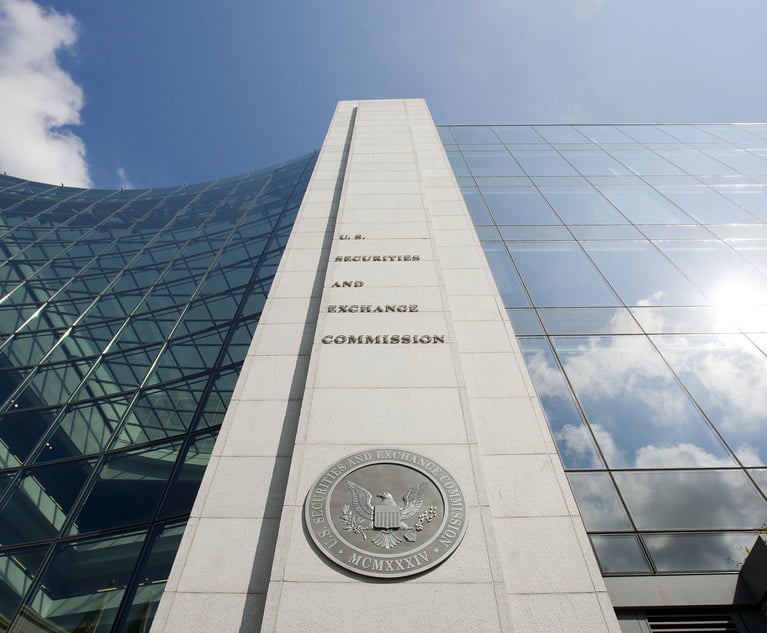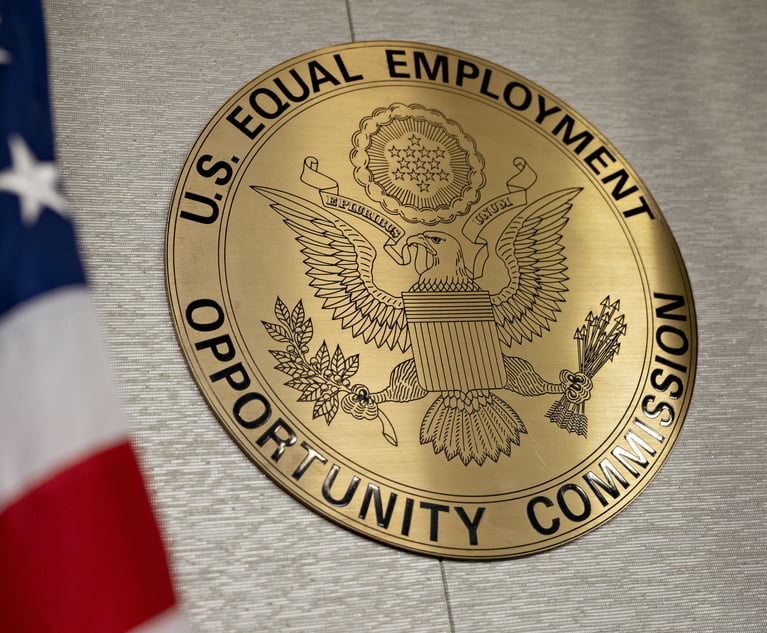Other Green Battles
Environmental law experts weigh in on two more environmental legal issues on the forefront.
March 31, 2009 at 08:00 PM
9 minute read
“Green Warfare” reported on the types of environmental litigation that may see a rise in prominence or activity under a new administration. The story discusses challenges to rulemaking, activist litigation, climate change torts and risk disclosure. Here, environmental law experts weigh in on two other environmental legal issues on the forefront.
Citizen Enforcement
Many federal and state environmental statutes allow citizens to file suit against violators when the government doesn't have the resources to do so. Kassie Siegel, senior counsel at the Center for Biological Diversity, explains why citizen suits aren't going anywhere:
I think you're going to see a bit of a lull here in some types of cases, but one of the most important aspects of our system of environmental law is the citizenship provision. Congress has long understood that, for political reasons, the executive branch is not always going to be enforcing these laws the way they should and that citizen enforcement is critically important. And while this administration is the best one that we've had in a long time, that doesn't mean they are any more insulated from politics than any other administration, and there's no reason to think that of citizen suits.
Congress understands and history has shown that citizen enforcement of our environmental laws is critically important. The cases that are ongoing now challenging the Bush atrocities need to be resolved–either through settlement with the new administration, which would be the best and the speediest; through Congressional action, which would also be very good; or because the cases just get resolved and the judge overturns these terrible regulations and attacks on environmental laws.
Even though the Obama administration is so much better than the Bush administration, [the Obama administration's executive branch] is not any more insulated from political realities than any other. For better or for worse, what that means is citizen enforcement of existing laws is critically important. There's no reason to think that's going to change completely.
Zoning Challenges
Even renewable energy companies face environmental challenges that aren't too dissimilar from the actions a mainstream company might see, such as challenges regarding manufacturing practices. Zoning issues continue to be a challenge for wind farms looking to set up shop. The debate over one proposed project in particular, Cape Wind, raged on for nearly a decade, perhaps bolstered by the fact that it is sited in Nantucket Sound off Cape Cod and counts residents like Ted Kennedy among its opponents. Peter Comodeca, a partner at Calfee who represents wind farms, explains the issues and why he expects the zoning process to get easier.
Obviously, the green community wants wind and solar to be the panacea for removing the carbon footprint from the sky, from the ground, etc.
However, when the wind energy farm is proposed for placement either onshore or offshore the same issues have been raised from a subset of the green community interested in scenic vistas, bird and bat migratory population, the running of power lines from the wind farm to the grid or to the community that will use it. Nobody wants that stuff in their view or property. That's pretty much still the same tension.
[In the Cape Wind matter] there was an issue of who had jurisdiction over permitting and regulating. That would be between the federal government and its control over navigable waters and the state and its control over underwater leasing and things of that nature. So there was actually a lawsuit with regard to that offshore process. There was a lawsuit that related to the nuisance of having the wind farm obstruct vistas and more aesthetic items. It's the regular discussion that happens when you have public hearings on siting any power plant, whether it be nuclear, fossil fuel, wind. It's the NIMBY–not in my backyard–argument.
[In January the U.S. Minerals Management Service issued a favorable final environmental assessment of the proposed site, which allowed Cape Wind to move forward]–but it took seven-and-a-half years. So while states are passing requirements to generate power through alternate energy, it still takes a long time to get through the siting and the permitting process, including [with] the EPA. The economic stimulus package has a major component dedicated to the generation of alternate energy production, and it needs to be sensitized to the risk of investing in alternative energy if there's such a long lead time before you can even turn a shovel.
I don't think seven-and-a-half years is sustainable. [Cape Wind] may be a case of first impression where the government was trying to get it right. I think the process will become easier as the various state and federal officials become more familiar with all the nuances of the new technology.
“Green Warfare” reported on the types of environmental litigation that may see a rise in prominence or activity under a new administration. The story discusses challenges to rulemaking, activist litigation, climate change torts and risk disclosure. Here, environmental law experts weigh in on two other environmental legal issues on the forefront.
Citizen Enforcement
Many federal and state environmental statutes allow citizens to file suit against violators when the government doesn't have the resources to do so. Kassie Siegel, senior counsel at the Center for Biological Diversity, explains why citizen suits aren't going anywhere:
I think you're going to see a bit of a lull here in some types of cases, but one of the most important aspects of our system of environmental law is the citizenship provision. Congress has long understood that, for political reasons, the executive branch is not always going to be enforcing these laws the way they should and that citizen enforcement is critically important. And while this administration is the best one that we've had in a long time, that doesn't mean they are any more insulated from politics than any other administration, and there's no reason to think that of citizen suits.
Congress understands and history has shown that citizen enforcement of our environmental laws is critically important. The cases that are ongoing now challenging the Bush atrocities need to be resolved–either through settlement with the new administration, which would be the best and the speediest; through Congressional action, which would also be very good; or because the cases just get resolved and the judge overturns these terrible regulations and attacks on environmental laws.
Even though the Obama administration is so much better than the Bush administration, [the Obama administration's executive branch] is not any more insulated from political realities than any other. For better or for worse, what that means is citizen enforcement of existing laws is critically important. There's no reason to think that's going to change completely.
Zoning Challenges
Even renewable energy companies face environmental challenges that aren't too dissimilar from the actions a mainstream company might see, such as challenges regarding manufacturing practices. Zoning issues continue to be a challenge for wind farms looking to set up shop. The debate over one proposed project in particular, Cape Wind, raged on for nearly a decade, perhaps bolstered by the fact that it is sited in Nantucket Sound off Cape Cod and counts residents like Ted Kennedy among its opponents. Peter Comodeca, a partner at Calfee who represents wind farms, explains the issues and why he expects the zoning process to get easier.
Obviously, the green community wants wind and solar to be the panacea for removing the carbon footprint from the sky, from the ground, etc.
However, when the wind energy farm is proposed for placement either onshore or offshore the same issues have been raised from a subset of the green community interested in scenic vistas, bird and bat migratory population, the running of power lines from the wind farm to the grid or to the community that will use it. Nobody wants that stuff in their view or property. That's pretty much still the same tension.
[In the Cape Wind matter] there was an issue of who had jurisdiction over permitting and regulating. That would be between the federal government and its control over navigable waters and the state and its control over underwater leasing and things of that nature. So there was actually a lawsuit with regard to that offshore process. There was a lawsuit that related to the nuisance of having the wind farm obstruct vistas and more aesthetic items. It's the regular discussion that happens when you have public hearings on siting any power plant, whether it be nuclear, fossil fuel, wind. It's the NIMBY–not in my backyard–argument.
[In January the U.S. Minerals Management Service issued a favorable final environmental assessment of the proposed site, which allowed Cape Wind to move forward]–but it took seven-and-a-half years. So while states are passing requirements to generate power through alternate energy, it still takes a long time to get through the siting and the permitting process, including [with] the EPA. The economic stimulus package has a major component dedicated to the generation of alternate energy production, and it needs to be sensitized to the risk of investing in alternative energy if there's such a long lead time before you can even turn a shovel.
I don't think seven-and-a-half years is sustainable. [Cape Wind] may be a case of first impression where the government was trying to get it right. I think the process will become easier as the various state and federal officials become more familiar with all the nuances of the new technology.
This content has been archived. It is available through our partners, LexisNexis® and Bloomberg Law.
To view this content, please continue to their sites.
Not a Lexis Subscriber?
Subscribe Now
Not a Bloomberg Law Subscriber?
Subscribe Now
NOT FOR REPRINT
© 2025 ALM Global, LLC, All Rights Reserved. Request academic re-use from www.copyright.com. All other uses, submit a request to [email protected]. For more information visit Asset & Logo Licensing.
You Might Like
View All

‘Extremely Disturbing’: AI Firms Face Class Action by ‘Taskers’ Exposed to Traumatic Content
5 minute read
In-House Lawyers Are Focused on Employment and Cybersecurity Disputes, But Looking Out for Conflict Over AI
Trending Stories
- 1Who Are the Judges Assigned to Challenges to Trump’s Birthright Citizenship Order?
- 2Litigators of the Week: A Directed Verdict Win for Cisco in a West Texas Patent Case
- 3Litigator of the Week Runners-Up and Shout-Outs
- 4Womble Bond Becomes First Firm in UK to Roll Out AI Tool Firmwide
- 5Will a Market Dominated by Small- to Mid-Cap Deals Give Rise to a Dark Horse US Firm in China?
Who Got The Work
J. Brugh Lower of Gibbons has entered an appearance for industrial equipment supplier Devco Corporation in a pending trademark infringement lawsuit. The suit, accusing the defendant of selling knock-off Graco products, was filed Dec. 18 in New Jersey District Court by Rivkin Radler on behalf of Graco Inc. and Graco Minnesota. The case, assigned to U.S. District Judge Zahid N. Quraishi, is 3:24-cv-11294, Graco Inc. et al v. Devco Corporation.
Who Got The Work
Rebecca Maller-Stein and Kent A. Yalowitz of Arnold & Porter Kaye Scholer have entered their appearances for Hanaco Venture Capital and its executives, Lior Prosor and David Frankel, in a pending securities lawsuit. The action, filed on Dec. 24 in New York Southern District Court by Zell, Aron & Co. on behalf of Goldeneye Advisors, accuses the defendants of negligently and fraudulently managing the plaintiff's $1 million investment. The case, assigned to U.S. District Judge Vernon S. Broderick, is 1:24-cv-09918, Goldeneye Advisors, LLC v. Hanaco Venture Capital, Ltd. et al.
Who Got The Work
Attorneys from A&O Shearman has stepped in as defense counsel for Toronto-Dominion Bank and other defendants in a pending securities class action. The suit, filed Dec. 11 in New York Southern District Court by Bleichmar Fonti & Auld, accuses the defendants of concealing the bank's 'pervasive' deficiencies in regards to its compliance with the Bank Secrecy Act and the quality of its anti-money laundering controls. The case, assigned to U.S. District Judge Arun Subramanian, is 1:24-cv-09445, Gonzalez v. The Toronto-Dominion Bank et al.
Who Got The Work
Crown Castle International, a Pennsylvania company providing shared communications infrastructure, has turned to Luke D. Wolf of Gordon Rees Scully Mansukhani to fend off a pending breach-of-contract lawsuit. The court action, filed Nov. 25 in Michigan Eastern District Court by Hooper Hathaway PC on behalf of The Town Residences LLC, accuses Crown Castle of failing to transfer approximately $30,000 in utility payments from T-Mobile in breach of a roof-top lease and assignment agreement. The case, assigned to U.S. District Judge Susan K. Declercq, is 2:24-cv-13131, The Town Residences LLC v. T-Mobile US, Inc. et al.
Who Got The Work
Wilfred P. Coronato and Daniel M. Schwartz of McCarter & English have stepped in as defense counsel to Electrolux Home Products Inc. in a pending product liability lawsuit. The court action, filed Nov. 26 in New York Eastern District Court by Poulos Lopiccolo PC and Nagel Rice LLP on behalf of David Stern, alleges that the defendant's refrigerators’ drawers and shelving repeatedly break and fall apart within months after purchase. The case, assigned to U.S. District Judge Joan M. Azrack, is 2:24-cv-08204, Stern v. Electrolux Home Products, Inc.
Featured Firms
Law Offices of Gary Martin Hays & Associates, P.C.
(470) 294-1674
Law Offices of Mark E. Salomone
(857) 444-6468
Smith & Hassler
(713) 739-1250







